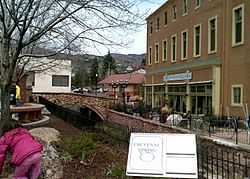Manitou Cliff Dwellings
 | |
 | |
| Established | 1907 |
|---|---|
| Location | 10 Cliff Road Manitou Springs, Colorado |
| Coordinates | 38°51′48″N 104°54′45″W / 38.8634°N 104.9124°W |
| Type | Archaeological museum |
| Website | www.cliffdwellingsmuseum.com |
The Manitou Cliff Dwellings are a privately owned tourist attraction[1][2] consisting of replica Ancestral Puebloan cliff dwellings[3] and interpretive exhibits located just west of Colorado Springs, Colorado, on U.S. Highway 24 in Manitou Springs.
The attraction was established using replica and reconstructed Pueblo cliff dwellings[2] in 1904 and was opened to the public in 1907.[4] An associated private museum features commercially developed displays about Ancestral Puebloan peoples[5] including exhibits of archaeological artifacts, tools, pottery, and weapons from Indigenous sites and/or replicated by the company that operates the site.[2] The replica dwellings were created as part of a commercial venture to divert tourists from Southwest archaeological sites by creating a version of a Pueblo dwelling place that was more easily accessible to early 20th century American visitors.[2] Visitors can walk through the replica dwellings, and various displays and interpretive material attempt to imbue the entire attraction with a sense of authenticity, though the Manitou Cliff Dwellings are not themselves authentic.[2]
History[edit]
The Ancestral Puebloans lived and travelled the Four Corners area of the Southwestern United States from 1200 B.C. to A.D. 1300. Ancestral Puebloan peoples did not permanently live in the Manitou Springs area, but lived and built their cliff dwellings in the Four Corners area and across the Northern Rio Grande, several hundred miles southwest of Manitou Springs. The Manitou Cliff Dwellings were built at their present location in the early 1900s, as a museum and tourist attraction. Some of the building materials were taken from a collapsed Ancestral Puebloan site near Cortez in southwest Colorado, shipped by railroad to Manitou Springs, and assembled in their present form as Ancestral Puebloan-style buildings resembling those found in the Four Corners.
The project was directed primarily by Virginia McClurg, founder of the Colorado Cliff Dwelling Association.[6][7] McClurg's creation of Manitou was highly controversial even at the time of its opening,[8] in part because it was being promoted as authentic,[2] and eventually caused the demise of the Colorado Cliff Dwelling Association and created rifts amongst Southwest archaeologists and enthusiasts.[2][9] Edgar Lee Hewett, a famous early Southwest anthropologist, is widely cited at Manitou and in the attraction's materials as having approved of its construction, but in reality, Hewett was reluctant to legitimize the site and had little regard for the reconstructions.[8] The McClurg family continues to operate the attraction to this day.
See also[edit]
| Manitou Springs, Colorado |
|---|
 |
References[edit]
- ^ "History". Manitou Cliff Dwellings. Retrieved 2021-07-03.
- ^ a b c d e f g Lovata, Troy R. (June 2011). "Archaeology as Built for the Tourists: The Anasazi Cliff Dwellings of Manitou Springs, Colorado". International Journal of Historical Archaeology. 15 (2): 194–205. doi:10.1007/s10761-011-0136-z. ISSN 1092-7697. S2CID 144387771.
- ^ Fowler, Don D. (1999). Harvard vs. Hewett: The contest for control of Southwestern archaeology, 1904-1930. in Assembling the Past: Studies in the Professionalization of Archaeology. Albuquerque: University of New Mexico Press. pp. 165–212.
- ^ Anasazi Museum Archived 2008-05-09 at the Wayback Machine
- ^ Lovata, Troy R. (2011-04-19). "Archaeology as Built for the Tourists: The Anasazi Cliff Dwellings of Manitou Springs, Colorado". International Journal of Historical Archaeology. 15 (2): 194–205. doi:10.1007/s10761-011-0136-z. ISSN 1573-7748. S2CID 144387771.
- ^ Troy Lovata, Inauthentic Archaeologies, (Walnut Creek, Calif: 2007, Left Coast Press) ISBN 978-1-59874-011-0, p.49-75.
- ^ Marshall Sprague, Newport in the Rockies: The Life & Good Times of Colorado Springs , (various editions, including Swallow Press, 1988) ISBN 978-0-8040-0899-0
- ^ a b Weixelman, J.O. (2004). Hidden Heritage: Pueblo Indians, National Parks, and the Myth of the 'Vanishing Anasazi. Albuquerque: Doctoral Dissertation, University of New Mexico. p. 392.
- ^ Smith, Duane A. (1988). "Mesa Verde National Park: shadows of the centuries". Development of Western Resources (USA).
